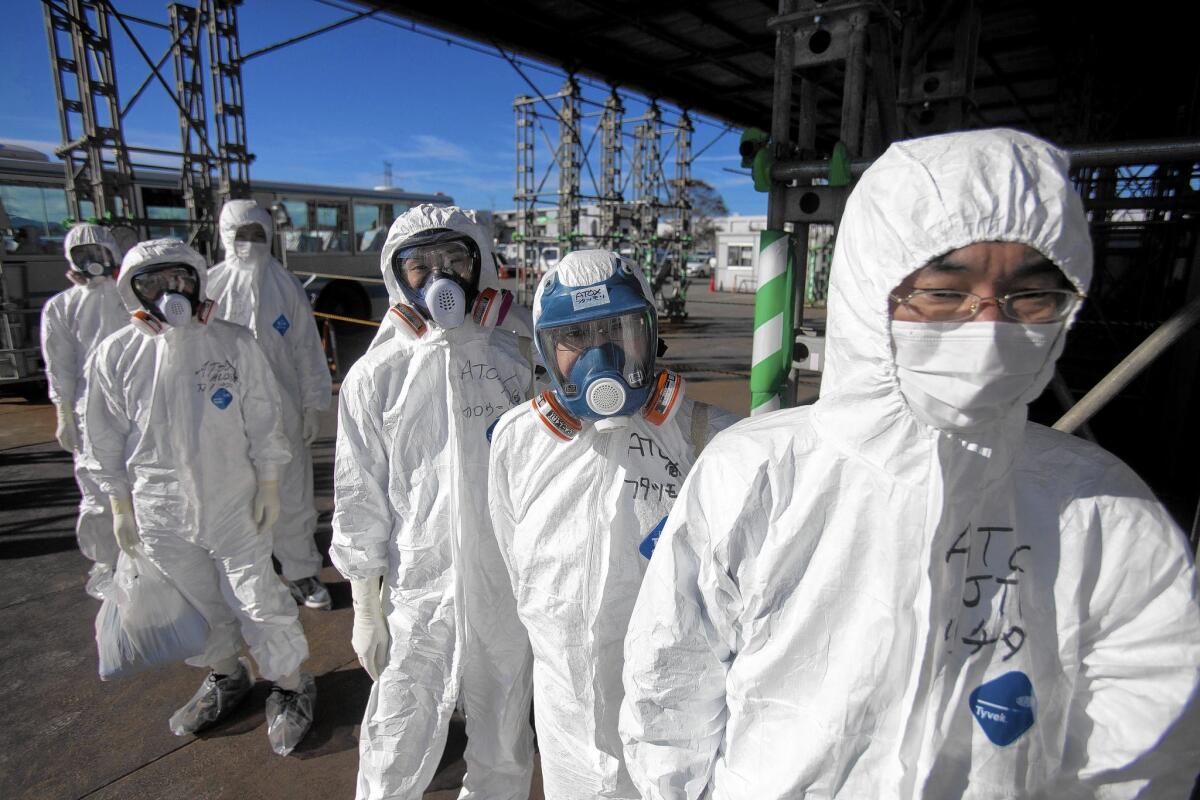‘Fukushima’ sounds warning on nuclear energy

- Share via
On March 18, 2011, an official from the U.S. Nuclear Regulatory Commission named Chuck Casto called together the NRC delegation on assignment with him in Tokyo.
“We’re in never-never land,” he told them.
Seven days earlier, a magnitude 9 earthquake had rattled a complex of six nuclear power plants known as Fukushima Daiichi, roughly 150 miles northeast of Tokyo. Then came nature’s second, more devastating blow: a tsunami that swamped the complex, flooding its electrical generators and putting its three operating reactors out of commission. The reactors were soon out of control, the plant effectively disabled by that most feared event in the nuclear industry: a “station blackout,” when no power is available to run any of the safety systems designed to defend the public from a runaway reaction.
In the days that followed, three explosions blew apart portions of two reactor buildings, and the reactors’ fuel cores at least partly melted down. Public officials steadily expanded the evacuation zone around the plant, eventually to 19 miles; the evacuation of Tokyo itself was briefly considered.
“Never-never land” barely did justice to the situation. Casto and his team had been flown to Japan to help deal with the crisis, but all that they knew was that the Japanese government and Tokyo Electric Power Co., which owned the plant, were at an almost complete loss about how to deal with the catastrophe, as was the Japanese government.
Today, nearly three years after the event, only two of Japan’s 50 nuclear power reactors have been permitted to restart. The wrecked Fukushima station has been leaking radioactive water into the Pacific.
These events and more are meticulously reconstructed in “Fukushima: The Story of a Nuclear Disaster” by David Lochbaum, Edwin Lyman and Susan Q. Stranahan of the Union of Concerned Scientists. Followers of Fukushima and its consequences for the nuclear power movement have come to rely on Lochbaum and Lyman for their scientific expertise on the topic. Stranahan, a journalist and writer whose experience with nuclear power dates back to her coverage of the Three Mile Island accident in 1979, is evidently responsible for the book’s lucid and gripping narrative.
No one with an interest in the present and future of nuclear power in the United States should miss it.
Books and news coverage about nuclear power coalesced into three periods, roughly tracking the fortunes and self-image of the industry itself. First came the years of optimism, starting in the late 1940s and extending into the 1950s, when physicists and government bureaucrats alike were eager to spread the idea of the “peaceful atom” as counterpoint to the image of nuclear technology as a tool of war established by the bombings of Hiroshima and Nagasaki. The U.S. government heavily subsidized the nascent nuclear power industry, and General Electric and Westinghouse, manufacturers of the two leading power reactor designs, offered nuclear plants to a willing utility industry on loss-leader terms.
But reactor technology was vastly more complex than anything America’s utilities had dealt with previously. Their executives and their workforces were incapable of safely managing the willful atom. Meanwhile, the U.S. Atomic Energy Commission kept a tight lid on its own staff’s reports of the health perils of radioactivity loosed into the environment and the implications of runaway reactions. Anxious to tamp down public opposition to the novel technology, the AEC issued earnest reassurances about the rigorous safety standards of the nation’s burgeoning fleet of nuclear power stations.
By the late 1970s the truth was beginning to leak out, in part through the indefatigable efforts of the Union of Concerned Scientists, the home of the authors of “Fukushima,” which used the Freedom of Information Act to spring reams of documents from purgatory. The years of doubt culminated in 1979, when the Three Mile Island accident underscored the inadequacy of the “human factor” in managing power reactors. Over the next 10 years, plans for more than 60 nuclear plants in the U.S. were canceled.
But with the turn of the century, interest in nuclear power returned. Today the atom is treated as a potential “green” energy source. The managerial shortcomings of the past supposedly have been overcome, and the safety of the technology supposedly has advanced.
“Fukushima” is an indispensable reminder of the nuclear power industry’s failure to learn from the past. The assurances of greater rigor in the operation and regulation of the peaceful atom after Three Mile Island are contradicted by the flaws exposed by Fukushima. As Lyman, one of the authors of this book, observed in congressional testimony shortly after the disaster, a similar event could happen in the U.S. “We have plants that are just as old. ... We have a regulatory system that is not clearly superior to that of the Japanese. We have had extreme weather events that exceeded our expectations and defeated our emergency planning.”
How safe is safe enough? Throughout the history of nuclear power, utilities and regulators have assured the public that their plants can withstand every emergency situation except the truly unimaginable. But the unimaginable can happen, as it did on the coast of Japan on March 11, 2011.
“Fukushima” shows in sobering detail what can follow when those with a vested interest in making the technology seem safer than it is decide not to plan for an extreme event because “it can’t happen here.” The authors remind us: Yes, it can.
Hiltzik, a Times business columnist, is the author of “The New Deal: A Modern History” and “Colossus: The Turbulent, Thrilling Saga of the Building of Hoover Dam.”
Fukushima
The Story of a Nuclear Disaster
David Lochbaum, Edwin Lyman, Susan Q. Stranahan and the Union of Concerned Scientists
New Press: 320 pp., $27.95
More to Read
Sign up for our Book Club newsletter
Get the latest news, events and more from the Los Angeles Times Book Club, and help us get L.A. reading and talking.
You may occasionally receive promotional content from the Los Angeles Times.











